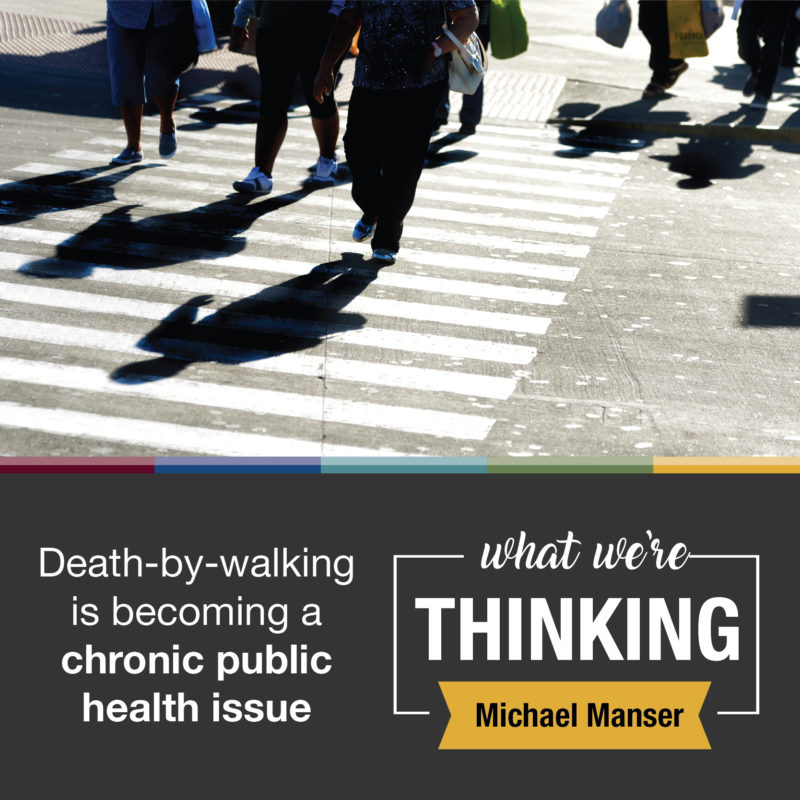Pedestrian dangers are nothing new. To traverse city streets a century ago, pedestrians had to navigate a gauntlet of cars, bicycles, horse-drawn buggies, trucks and streetcars, typically unencumbered by expectations that they do so at designated crosswalks. But city streets have changed dramatically since then, as have all of the vehicular dynamics that influence safety. One thing that hasn’t changed, however, is the peril for those in urban areas who choose to walk for either practical or recreational reasons.
U.S. pedestrian deaths rose to 6,227 in 2018, reaching their highest level in 28 years, according to a projection by the Governors Highway Safety Association. Pedestrian deaths account for a steadily rising share of total traffic deaths, from 11% in 2007 to 16% now, according to the National Highway Traffic Safety Administration.
We should be asking two very important questions regarding the safety of pedestrians: Why is this happening, and what should we do about it?
The reasons for the spike in pedestrian deaths are, by and large, similar to the reasons why people die or suffer injuries in vehicle crashes.
Exposure: People in vehicles are traveling more miles, spurred along by low gas prices. The GHSA says that more people are walking to work, too (up 4% from 2007 to 2016). With more cars and more walkers sharing common space, the likelihood of collisions involving both is simply greater.
Distraction: Pedestrians are crossing the streets with their eyes down — looking at their smart phones. Clearly, being on a cell phone behind the wheel isn’t the only way in which distractions can be deadly.
Alcohol impairment: 39% of pedestrian fatalities result from walking while intoxicated. Here in Texas, according the Texas Department of Transportation Crash Records Information Service for 2010-2017, the average blood alcohol concentration of fatal and seriously injured pedestrians, with a concentration greater than zero, was .197 — more than twice the legal limit to drive and enough to make walking a serious challenge for most pedestrians.
Limited vision: 75% of fatalities happen after dark, according to GHSA and NHTSA.
Vehicle size: Pedestrian deaths involving sport utility vehicles are up by 50% from 2013 to 2017, while the proportion is up by 30% for non-SUV sedans. A great many of the people who buy SUVs do so because the modest elevation boost promises a greater measure of visibility, but the larger vehicle size poses a greater risk for pedestrians. Advancement in vehicle safety features such as multiple airbags and seatbelts have done much to protect occupants when a crash happens, but they do nothing to enhance survivability for pedestrians.
There’s also a chance that marijuana may be playing a role. States that have legalized recreational pot use have seen an increase in pedestrian deaths, though we don’t yet have enough data to draw a definitive link. Another potential culprit has zipped into the picture over the past year or so — electric scooters. But as they relate to pedestrian safety, we need more data there, too.
We already have infrastructure and engineering solutions we know will work for roads and vehicles. Being thoughtful about how we design and regulate the use of our transportation ecosystem can prevent much of the carnage imposed on pedestrians. A more careful and robust examination of pedestrian dangers can do so, as well. This is where cities can make the biggest improvements — if they emulate a few insightful precedents out there.
The city of Austin offers a meaningful illustration, and the same is true for the city of Portland, Oregon. Each addresses pedestrian safety in a holistic fashion, examining cause factors at a deep level. And each considers community priorities in terms of equity and environmental health as well as enforcement and infrastructure engineering. Most cities fall short of such standards for several reasons, including a lack of sufficient resources to identify the underlying problems and develop appropriate measures to improve safety.
Take, for example, the question of who is involved, and whether some demographic groups might be over-represented. Analysis in Austin showed how non-English-speaking and lower-income residents are more likely to be in a pedestrian crash. Areas with lower rates of car ownership and higher rates of transit use are at greater risk, too, as are older pedestrians, males and the homeless.
Understanding these non-engineering factors is essential, because countermeasures may require non-engineering solutions. As simple as that sounds, it’s not easy because the idea faces the same challenge encountered by all safety improvement strategies: money. To make wise safety investments, information and data analysis is crucial.
Pedestrian safety dangers exist at the local community level, and it is local community leaders who have to address them and fund their solutions. To make meaningful progress, those leaders need to first understand the problems better. To that end, they will need to rely on spreadsheets as well as sidewalks.
Michael Manser is a Senior Research Scientist with the Texas A&M Transportation Institute.
This article was originally published in the TribTalk, May 20, 2019.
